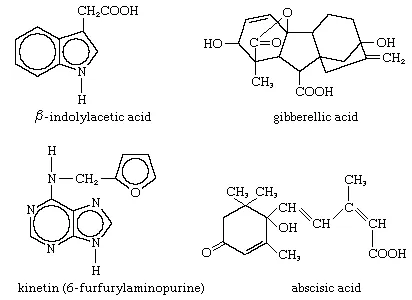Plant Growth Regulators and their Physiological Effects
A plant growth regulator may be defined as any organic substance produced by the plant in less concentration which shows its physiological response at a place in the plant other than the place of synthesis. It is also called phytohormone. Broadly plant growth regulator are classified as follows:
- Promoter: Auxin, Gibberellins and Cytokinins
- Growth Inhibitor: Abscissic acid and Ethylene
Types of plant growth regulators:
- Auxins
These are first discovered phytohormones. Auxin is isolated sucesfully in agar blocks by F.W.Went.
Physiological effects:
- Cell elongation
- Root initiation
- Apical dominance
- Parthenocarpy
- Sex determination
- Gibberellins
Gibberellins was first discovered in bakanae disease of rice caused by Gibberella fujikuroi. Gibberellins are large group of Phytohormones. So far about 110 different types of gibberellins have been discovered from different plant groups.
Physiological effects:
- Removable of Genetical dwarfism
- Seed germination
- Bolting and Flowering
- Formation of Parthenocarpic fruits
- Sex determination
- Cytokinins
Synthetic cytokinins are Benzyl adenine (BA) and Benzyl amino purine (BAP). Young embryos are rich in cytokinins. These hormones are generally synthesized in the root and then transported to shoot system.
Physiological effects:
- Cell Division
- Cell expansion
- Morphogenesis (Organ formation)
- Delay in Senescence
- Stomatal Opening
- Abscissic acid
It is growth-inhibiting substance that promotes the senescence of leaves and induction of dormancy in buds and seeds. To protect the plant from water stress it is synthesized in stress condition. Hence it is called as Stress hormone. It is abundantly present in dormant buds, seeds and senescent leaves. Till now abscissic acid is not reported from root.
Physiological effects:
- Induce seed and bud dormancy
- Stomatal closure
- Formation of Perennating buds
- Senescence of Leaves
- Ethylene
Ethylene is gaseous hormone which is produced in all parts of the plant. It is synthesized from the amino acid Methionine.
Physiological effects
- Fruit ripening
- Triple Response Growth
- Flowering
- Promotes leaf abscission.
- Induces flower senescence.
- Promotes female flower formation in cucurbits.
- Removes or inhibits apical dominance.
- Promotes growth or divisions at wounded regions and plays a role in wound healing.

